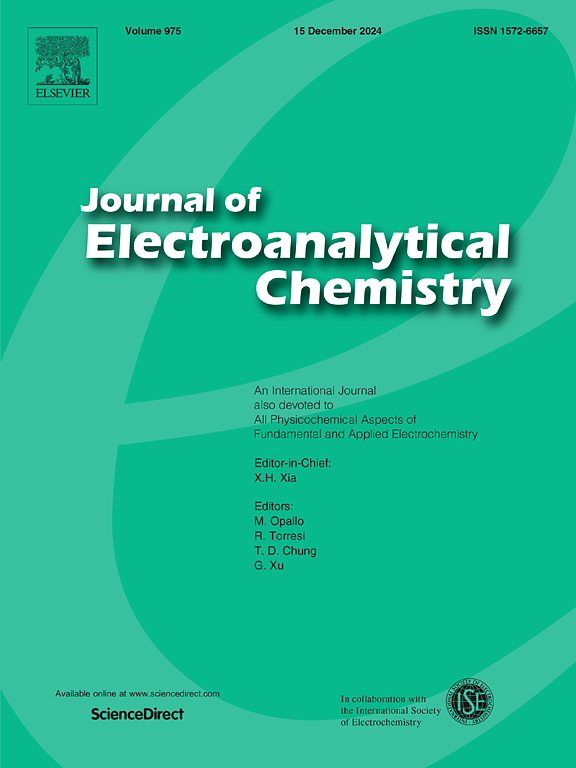基于甲基丙烯酸酯化合物探针的新型半胱氨酸检测电化学传感器
IF 4.1
3区 化学
Q1 CHEMISTRY, ANALYTICAL
引用次数: 0
摘要
采用简便的一步法合成了1,4-双(2-甲基丙烯氧基)苯(BMOB),并将其作为选择性测定半胱氨酸的电化学探针。BMOB通过Michael加成反应与半胱氨酸的巯基发生反应,然后发生分子内环化反应,释放出电活性酚类物质。通过检测裸露的玻碳电极上电活性酚醛物质的氧化电信号,实现了半胱氨酸的准确测定。采用高分辨率质谱和差分脉冲伏安法证实了BMOB与半胱氨酸的反应机理。为了获得更高的灵敏度,对实验条件进行了优化。在5.0 μM ~ 100.0 μM范围内,电流峰值与半胱氨酸浓度呈良好的线性关系,相关系数为0.9978。BMOB的检出限为0.29 μM (S/N = 3),对6-巯基-1-己醇、同型半胱氨酸和谷胱甘肽不敏感,具有较高的选择性。基于bmoba -半胱氨酸反应的电化学传感器成功地检测了加标大鼠血清和小儿复合氨基酸注射液(18AA-I)中的半胱氨酸,具有高选择性、重复性和准确性。与其他复杂的分析方法或繁琐的电极修饰过程相比,本工作为在传统未经修饰的电极上准确检测半胱氨酸提供了一种简单方便的方法。本文章由计算机程序翻译,如有差异,请以英文原文为准。

A novel electrochemical sensor for detection of cysteine based on a Methacrylic Ester compound probe
1,4-bis(2-methacryloxy)benzene (BMOB) was synthesized through a facile one-step reaction and was used as an electrochemical probe for the selective determination of cysteine. BMOB reacted with the sulphydryl group of cysteine by a Michael addition reaction, then underwent the intramolecular cyclization reaction and released the electroactive phenolic substance. The accurate determination of cysteine was realized by detecting the oxidation electrical signal of the electroactive phenolic substance on the bare glassy carbon electrode. The reaction mechanism between BMOB and cysteine was proved by high-resolution mass spectrum and differential pulse voltammetry. The experimental conditions were optimized to obtain higher sensitivity. A plot of peak current versus cysteine concentration exhibited a well-linear relationship in the range of 5.0 μM - 100.0 μM, with a correlation coefficient of 0.9978. The limit of detection was calculated to be 0.29 μM (S/N = 3). BMOB was insensitive to 6-Mercapto-1-hexanol, homocysteine and glutathione, indicating relatively high selectivity. The developed electrochemical sensor based on BMOB-cysteine reaction successfully detected cysteine in spiked rat serum and Paediatric Compound Amino Acid Injection(18AA-I)with high selectivity, reproducibility and accuracy. Compared with other complicated analytical methods or tedious electrode modification processes, this work provided a simple and convenient approach for the accurate detection of cysteine on traditional unmodified electrodes.
求助全文
通过发布文献求助,成功后即可免费获取论文全文。
去求助
来源期刊
CiteScore
7.80
自引率
6.70%
发文量
912
审稿时长
2.4 months
期刊介绍:
The Journal of Electroanalytical Chemistry is the foremost international journal devoted to the interdisciplinary subject of electrochemistry in all its aspects, theoretical as well as applied.
Electrochemistry is a wide ranging area that is in a state of continuous evolution. Rather than compiling a long list of topics covered by the Journal, the editors would like to draw particular attention to the key issues of novelty, topicality and quality. Papers should present new and interesting electrochemical science in a way that is accessible to the reader. The presentation and discussion should be at a level that is consistent with the international status of the Journal. Reports describing the application of well-established techniques to problems that are essentially technical will not be accepted. Similarly, papers that report observations but fail to provide adequate interpretation will be rejected by the Editors. Papers dealing with technical electrochemistry should be submitted to other specialist journals unless the authors can show that their work provides substantially new insights into electrochemical processes.

 求助内容:
求助内容: 应助结果提醒方式:
应助结果提醒方式:


